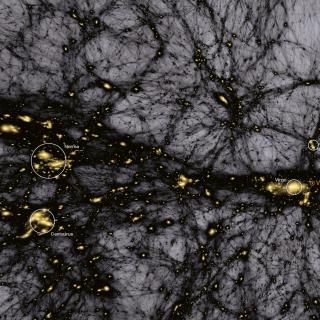Bibcode
Hernán-Caballero, A.; Akhlaghi, M.; López-Sanjuan, C.; Vázquez Ramió, H.; Laur, J.; Varela, J.; Civera, T.; Muniesa, D.; Finoguenov, A.; Fernández-Ontiveros, J. A.; Domínguez Sánchez, H.; Chaves-Montero, J.; Fernández-Soto, A.; Lumbreras-Calle, A.; Díaz-García, L. A.; del Pino, A.; González Delgado, R. M.; Hernández-Monteagudo, C.; Coelho, P.; Jiménez-Teja, Y.; Lopes, P. A. A.; Marra, V.; Tempel, E.; Vílchez, J. M.; Abramo, R.; Alcaniz, J.; Benítez, N.; Bonoli, S.; Carneiro, S.; Cenarro, J.; Cristóbal-Hornillos, D.; Dupke, R.; Ederoclite, A.; Marín-Franch, A.; Mendes de Oliveira, C.; Moles, M.; Sodré, L.; Taylor, K.
Referencia bibliográfica
Astronomy and Astrophysics
Fecha de publicación:
4
2024
Revista
Número de citas
4
Número de citas referidas
3
Descripción
We present a new method for obtaining photometric redshifts (photo-z) for sources observed by multiple photometric surveys using a combination (conflation) of the redshift probability distributions (PDZs) obtained independently from each survey. The conflation of the PDZs has several advantages over the usual method of modelling all the photometry together, including the modularity, speed, and accuracy of the results. Using a sample of galaxies with narrow-band photometry in 56 bands from J-PAS and deeper grίzy photometry from the Hyper-SuprimeCam Subaru Strategic program (HSC-SSP), we show that PDZ conflation significantly improves photo-z accuracy compared to fitting all the photometry or using a weighted average of point estimates. The improvement over J-PAS alone is particularly strong for i≳22 sources, which have low signal-to-noise ratios in the J-PAS bands. For the entire i<22.5 sample, we obtain a 64% (45%) increase in the number of sources with redshift errors |Δz|<0.003, a factor of 3.3 (1.9) decrease in the normalised median absolute deviation of the errors (σNMAD), and a factor of 3.2 (1.3) decrease in the outlier rate (η) compared to J-PAS (HSC-SSP) alone. The photo-z accuracy gains from combining the PDZs of J-PAS with a deeper broad-band survey such as HSC-SSP are equivalent to increasing the depth of J-PAS observations by ~ 1.2-1.5 mag. These results demonstrate the potential of PDZ conflation and highlight the importance of including the full PDZs in photo-z catalogues.
Proyectos relacionados

Cosmología con Trazadores de la Estructura a Gran Escala del Universo
El Fondo Cósmico de Microondas (FCM) contiene la información estadística de las semillas primigenias que han dado lugar a la formación de todas las estructuras en el Universo. Su contrapartida natural en el Universo local es la distribución de las galaxias que surgen como resultado del crecimiento gravitatorio de aquellas fluctuaciones de densidad
FRANCISCO SHU
KITAURA JOYANES